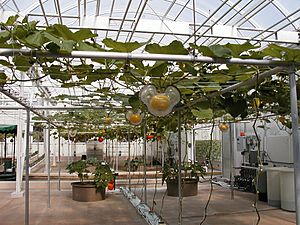Unusually shaped fruits and vegetables facts for kids
Sometimes, fruits and vegetables grow in really surprising shapes! Instead of looking like a typical apple or carrot, they might twist, bend, or even look like something else entirely. This happens when their normal growth plan changes a little. People often find these funny shapes amusing, especially if they look like a body part. Sometimes, people even imagine seeing faces or other familiar things in these oddly shaped veggies. This is called Pareidolia.
Contents
Why Do Fruits and Veggies Grow Oddly?
Fruits and vegetables usually get their unusual shapes because of things in their environment. If one part of a growing vegetable gets hurt, it might slow down in that spot. The rest of the vegetable keeps growing normally, leading to a strange shape.
For example, if the tip of a root vegetable (like a carrot) gets damaged, it can split. This makes it grow into multiple roots all joined at one point. If a plant is very young, even a small injury can cause bigger changes to its shape as it grows.
Forcing Shapes on Produce
Sometimes, farmers actually help vegetables grow into unique shapes on purpose! In Japan, farmers in the Zentsuji region found a way to grow square watermelons. They put the growing watermelons into glass boxes. The fruit then naturally takes on the shape of the box.
These square watermelons were first made to be easier to stack and store. However, they have to be picked before they are fully ripe, so you can't eat them. Also, these cubic watermelons often cost more than twice as much as regular ones! Using similar tricks, growers have also made watermelons shaped like dice, pyramids, or even faces.
Obstacles in the Soil
Root vegetables like carrots and parsnips often grow around things in the soil. They might bend to avoid small stones or other objects. This helps protect the growing root from damage. Because of this, you can find many different and interesting shapes of carrots and parsnips!
Fighting Food Waste
A lot of fruits and vegetables grown for stores never get eaten. Around 40% of them are thrown away because they don't look "perfect." They might be too big, too small, or just have an unusual shape. Even though they are perfectly good to eat, stores often won't sell them.
To help stop this food waste, some campaigns encourage people to buy oddly shaped fruits and vegetables. In France, there's a campaign called "Fruits et légumes moches" (Ugly Fruits and Vegetables). A similar effort, "Frutta Brutta" (Ugly Fruit), started in Milan, Italy. Many new businesses in the US have also begun selling or finding uses for these "ugly" but perfectly good foods.
Fun Competitions
In some places, people love to celebrate the unique shapes of vegetables. They even have competitions for the most unusual ones! These contests often judge vegetables based on how strange or funny they look. Some groups also hold contests for gardeners who grow the largest vegetables.
Unusual Veggies in Pop Culture
Oddly shaped vegetables have even appeared on TV! The popular BBC show That's Life! used to feature funny segments about unusual vegetables.
The BBC comedy show Blackadder also had jokes about strange vegetables. One character, Baldrick, was obsessed with oddly shaped turnips.
Gallery
-
"Twin" courgette/zucchini
-
A strawberry "man"
-
An unusually shaped cherry
-
Entwined carrots









